ACCT1001 - Financial Planning: Budgeting, Investment Decisions
VerifiedAdded on 2023/06/07
|9
|1949
|169
Homework Assignment
AI Summary
This assignment solution for ACCT1001 covers several key areas of business finance. It begins with break-even point (BEP) calculations, including determining BEP in units and monetary terms, and the number of units required to achieve a desired profit. The solution then presents a cash bu...
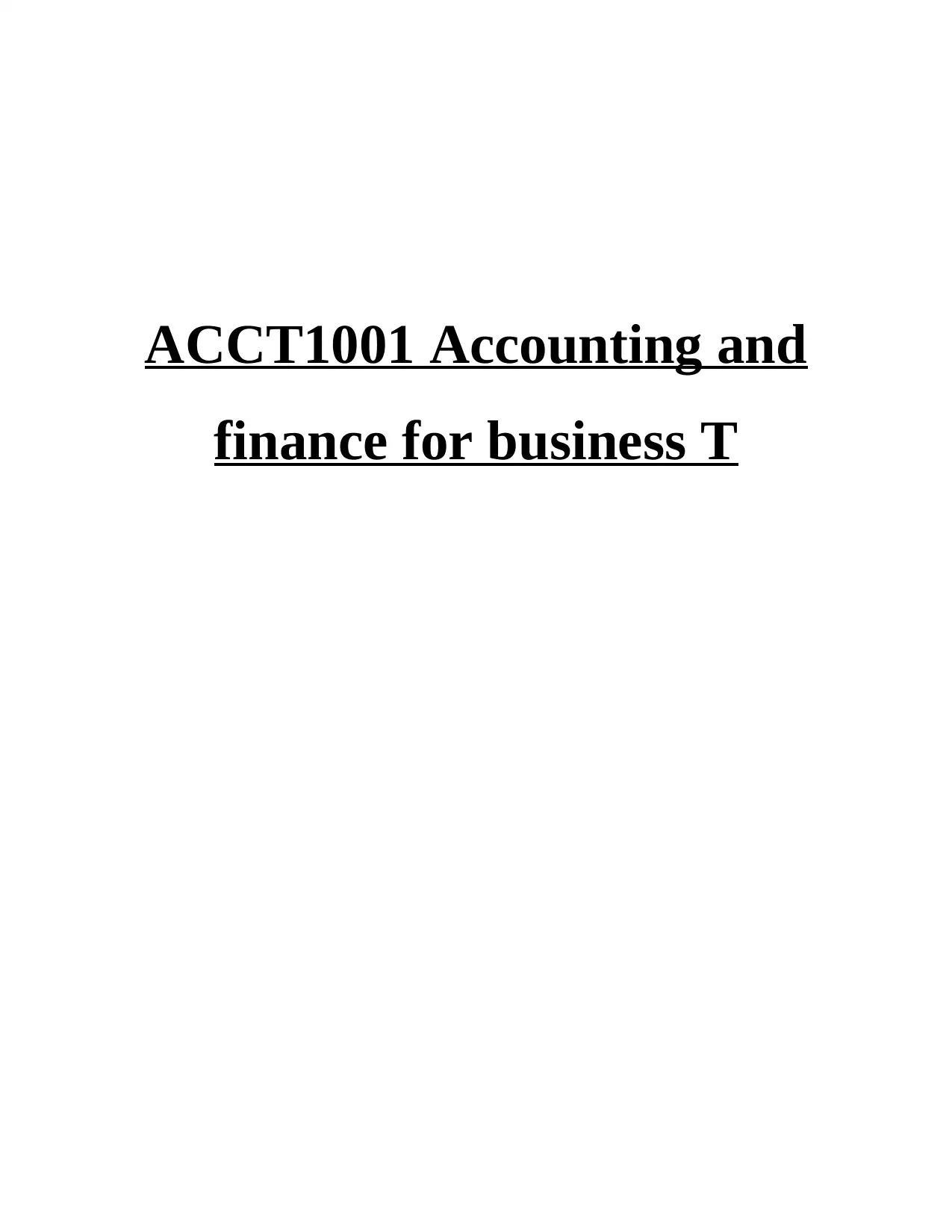
ACCT1001 Accounting and
finance for business T
finance for business T
Paraphrase This Document
Need a fresh take? Get an instant paraphrase of this document with our AI Paraphraser
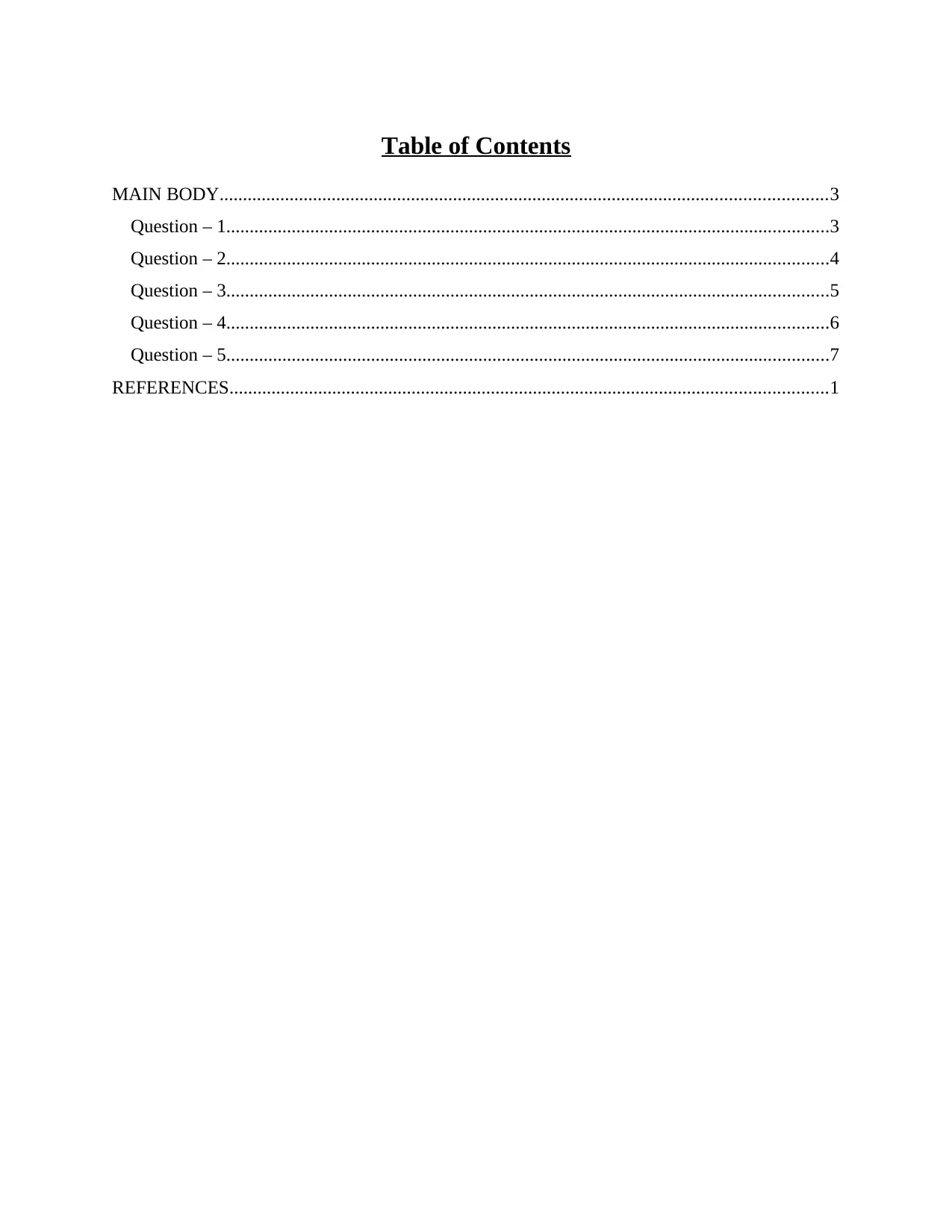
Table of Contents
MAIN BODY..................................................................................................................................3
Question – 1.................................................................................................................................3
Question – 2.................................................................................................................................4
Question – 3.................................................................................................................................5
Question – 4.................................................................................................................................6
Question – 5.................................................................................................................................7
REFERENCES................................................................................................................................1
MAIN BODY..................................................................................................................................3
Question – 1.................................................................................................................................3
Question – 2.................................................................................................................................4
Question – 3.................................................................................................................................5
Question – 4.................................................................................................................................6
Question – 5.................................................................................................................................7
REFERENCES................................................................................................................................1
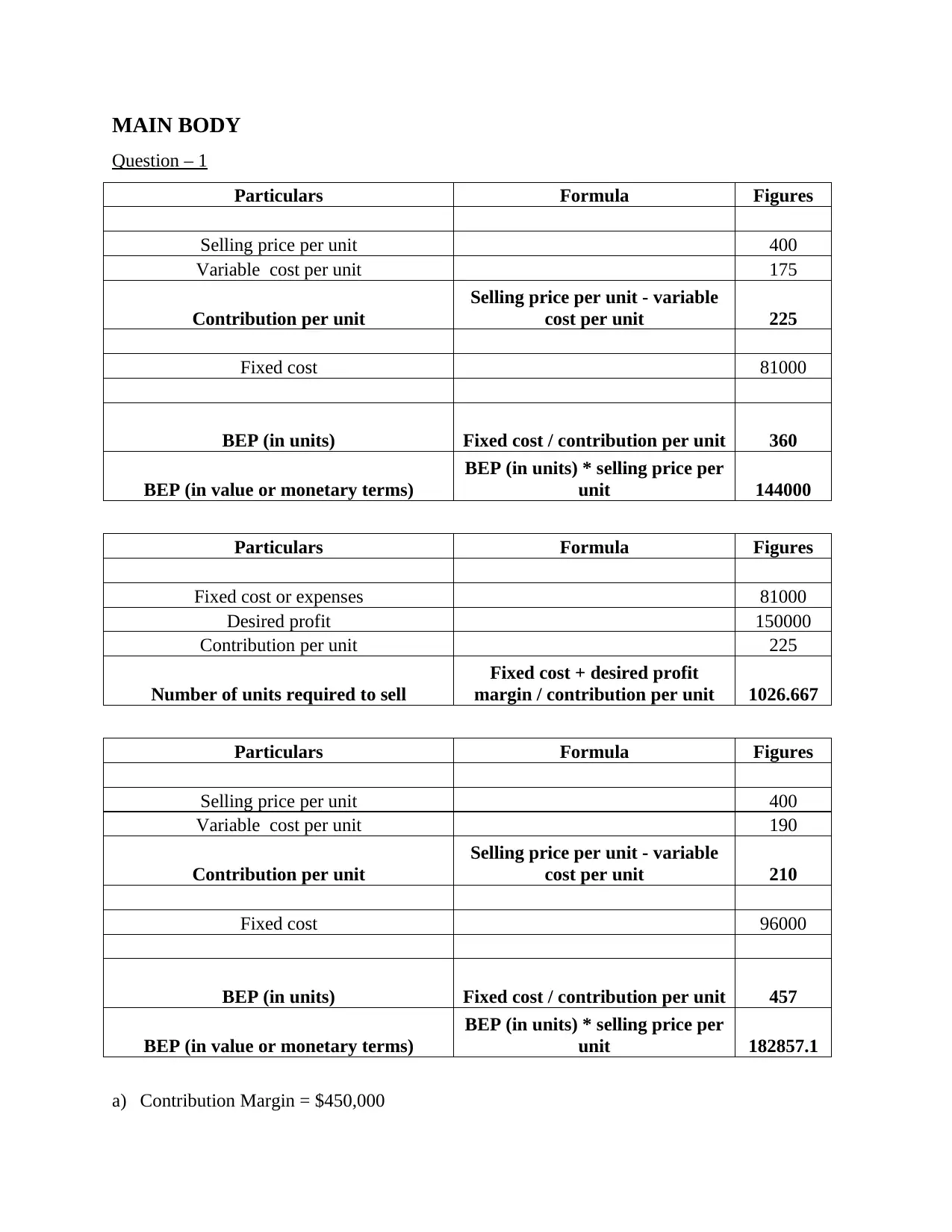
MAIN BODY
Question – 1
Particulars Formula Figures
Selling price per unit 400
Variable cost per unit 175
Contribution per unit
Selling price per unit - variable
cost per unit 225
Fixed cost 81000
BEP (in units) Fixed cost / contribution per unit 360
BEP (in value or monetary terms)
BEP (in units) * selling price per
unit 144000
Particulars Formula Figures
Fixed cost or expenses 81000
Desired profit 150000
Contribution per unit 225
Number of units required to sell
Fixed cost + desired profit
margin / contribution per unit 1026.667
Particulars Formula Figures
Selling price per unit 400
Variable cost per unit 190
Contribution per unit
Selling price per unit - variable
cost per unit 210
Fixed cost 96000
BEP (in units) Fixed cost / contribution per unit 457
BEP (in value or monetary terms)
BEP (in units) * selling price per
unit 182857.1
a) Contribution Margin = $450,000
Question – 1
Particulars Formula Figures
Selling price per unit 400
Variable cost per unit 175
Contribution per unit
Selling price per unit - variable
cost per unit 225
Fixed cost 81000
BEP (in units) Fixed cost / contribution per unit 360
BEP (in value or monetary terms)
BEP (in units) * selling price per
unit 144000
Particulars Formula Figures
Fixed cost or expenses 81000
Desired profit 150000
Contribution per unit 225
Number of units required to sell
Fixed cost + desired profit
margin / contribution per unit 1026.667
Particulars Formula Figures
Selling price per unit 400
Variable cost per unit 190
Contribution per unit
Selling price per unit - variable
cost per unit 210
Fixed cost 96000
BEP (in units) Fixed cost / contribution per unit 457
BEP (in value or monetary terms)
BEP (in units) * selling price per
unit 182857.1
a) Contribution Margin = $450,000
⊘ This is a preview!⊘
Do you want full access?
Subscribe today to unlock all pages.

Trusted by 1+ million students worldwide
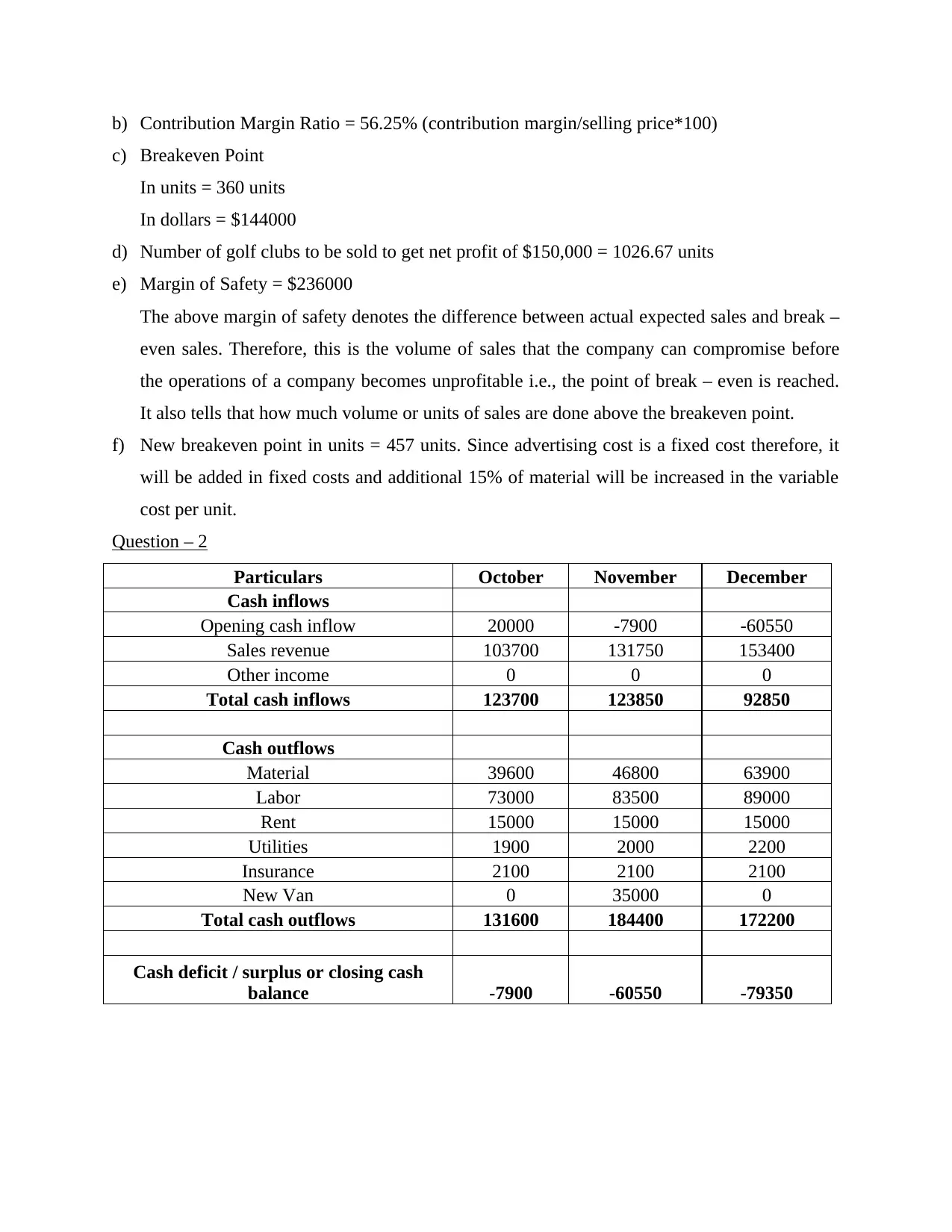
b) Contribution Margin Ratio = 56.25% (contribution margin/selling price*100)
c) Breakeven Point
In units = 360 units
In dollars = $144000
d) Number of golf clubs to be sold to get net profit of $150,000 = 1026.67 units
e) Margin of Safety = $236000
The above margin of safety denotes the difference between actual expected sales and break –
even sales. Therefore, this is the volume of sales that the company can compromise before
the operations of a company becomes unprofitable i.e., the point of break – even is reached.
It also tells that how much volume or units of sales are done above the breakeven point.
f) New breakeven point in units = 457 units. Since advertising cost is a fixed cost therefore, it
will be added in fixed costs and additional 15% of material will be increased in the variable
cost per unit.
Question – 2
Particulars October November December
Cash inflows
Opening cash inflow 20000 -7900 -60550
Sales revenue 103700 131750 153400
Other income 0 0 0
Total cash inflows 123700 123850 92850
Cash outflows
Material 39600 46800 63900
Labor 73000 83500 89000
Rent 15000 15000 15000
Utilities 1900 2000 2200
Insurance 2100 2100 2100
New Van 0 35000 0
Total cash outflows 131600 184400 172200
Cash deficit / surplus or closing cash
balance -7900 -60550 -79350
c) Breakeven Point
In units = 360 units
In dollars = $144000
d) Number of golf clubs to be sold to get net profit of $150,000 = 1026.67 units
e) Margin of Safety = $236000
The above margin of safety denotes the difference between actual expected sales and break –
even sales. Therefore, this is the volume of sales that the company can compromise before
the operations of a company becomes unprofitable i.e., the point of break – even is reached.
It also tells that how much volume or units of sales are done above the breakeven point.
f) New breakeven point in units = 457 units. Since advertising cost is a fixed cost therefore, it
will be added in fixed costs and additional 15% of material will be increased in the variable
cost per unit.
Question – 2
Particulars October November December
Cash inflows
Opening cash inflow 20000 -7900 -60550
Sales revenue 103700 131750 153400
Other income 0 0 0
Total cash inflows 123700 123850 92850
Cash outflows
Material 39600 46800 63900
Labor 73000 83500 89000
Rent 15000 15000 15000
Utilities 1900 2000 2200
Insurance 2100 2100 2100
New Van 0 35000 0
Total cash outflows 131600 184400 172200
Cash deficit / surplus or closing cash
balance -7900 -60550 -79350
Paraphrase This Document
Need a fresh take? Get an instant paraphrase of this document with our AI Paraphraser
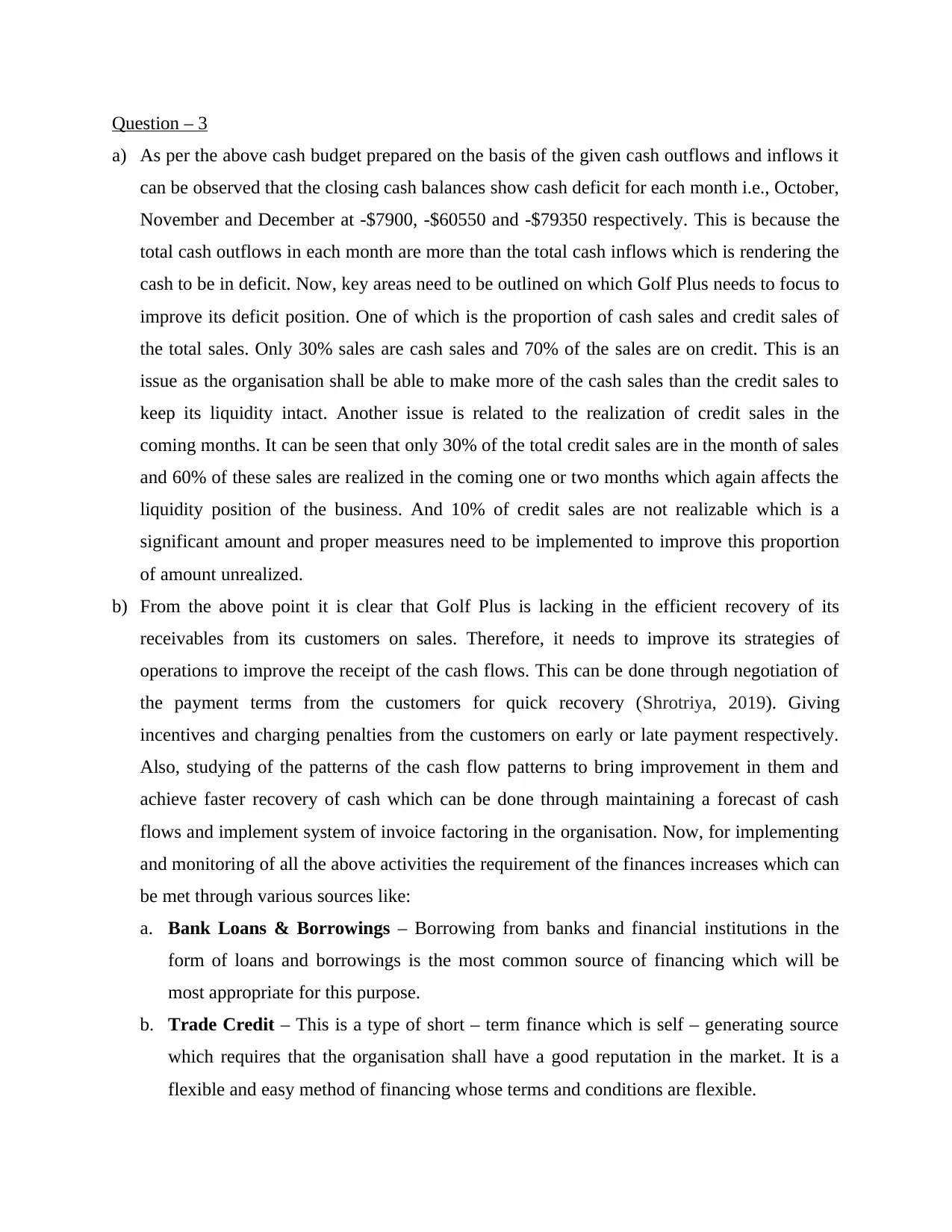
Question – 3
a) As per the above cash budget prepared on the basis of the given cash outflows and inflows it
can be observed that the closing cash balances show cash deficit for each month i.e., October,
November and December at -$7900, -$60550 and -$79350 respectively. This is because the
total cash outflows in each month are more than the total cash inflows which is rendering the
cash to be in deficit. Now, key areas need to be outlined on which Golf Plus needs to focus to
improve its deficit position. One of which is the proportion of cash sales and credit sales of
the total sales. Only 30% sales are cash sales and 70% of the sales are on credit. This is an
issue as the organisation shall be able to make more of the cash sales than the credit sales to
keep its liquidity intact. Another issue is related to the realization of credit sales in the
coming months. It can be seen that only 30% of the total credit sales are in the month of sales
and 60% of these sales are realized in the coming one or two months which again affects the
liquidity position of the business. And 10% of credit sales are not realizable which is a
significant amount and proper measures need to be implemented to improve this proportion
of amount unrealized.
b) From the above point it is clear that Golf Plus is lacking in the efficient recovery of its
receivables from its customers on sales. Therefore, it needs to improve its strategies of
operations to improve the receipt of the cash flows. This can be done through negotiation of
the payment terms from the customers for quick recovery (Shrotriya, 2019). Giving
incentives and charging penalties from the customers on early or late payment respectively.
Also, studying of the patterns of the cash flow patterns to bring improvement in them and
achieve faster recovery of cash which can be done through maintaining a forecast of cash
flows and implement system of invoice factoring in the organisation. Now, for implementing
and monitoring of all the above activities the requirement of the finances increases which can
be met through various sources like:
a. Bank Loans & Borrowings – Borrowing from banks and financial institutions in the
form of loans and borrowings is the most common source of financing which will be
most appropriate for this purpose.
b. Trade Credit – This is a type of short – term finance which is self – generating source
which requires that the organisation shall have a good reputation in the market. It is a
flexible and easy method of financing whose terms and conditions are flexible.
a) As per the above cash budget prepared on the basis of the given cash outflows and inflows it
can be observed that the closing cash balances show cash deficit for each month i.e., October,
November and December at -$7900, -$60550 and -$79350 respectively. This is because the
total cash outflows in each month are more than the total cash inflows which is rendering the
cash to be in deficit. Now, key areas need to be outlined on which Golf Plus needs to focus to
improve its deficit position. One of which is the proportion of cash sales and credit sales of
the total sales. Only 30% sales are cash sales and 70% of the sales are on credit. This is an
issue as the organisation shall be able to make more of the cash sales than the credit sales to
keep its liquidity intact. Another issue is related to the realization of credit sales in the
coming months. It can be seen that only 30% of the total credit sales are in the month of sales
and 60% of these sales are realized in the coming one or two months which again affects the
liquidity position of the business. And 10% of credit sales are not realizable which is a
significant amount and proper measures need to be implemented to improve this proportion
of amount unrealized.
b) From the above point it is clear that Golf Plus is lacking in the efficient recovery of its
receivables from its customers on sales. Therefore, it needs to improve its strategies of
operations to improve the receipt of the cash flows. This can be done through negotiation of
the payment terms from the customers for quick recovery (Shrotriya, 2019). Giving
incentives and charging penalties from the customers on early or late payment respectively.
Also, studying of the patterns of the cash flow patterns to bring improvement in them and
achieve faster recovery of cash which can be done through maintaining a forecast of cash
flows and implement system of invoice factoring in the organisation. Now, for implementing
and monitoring of all the above activities the requirement of the finances increases which can
be met through various sources like:
a. Bank Loans & Borrowings – Borrowing from banks and financial institutions in the
form of loans and borrowings is the most common source of financing which will be
most appropriate for this purpose.
b. Trade Credit – This is a type of short – term finance which is self – generating source
which requires that the organisation shall have a good reputation in the market. It is a
flexible and easy method of financing whose terms and conditions are flexible.
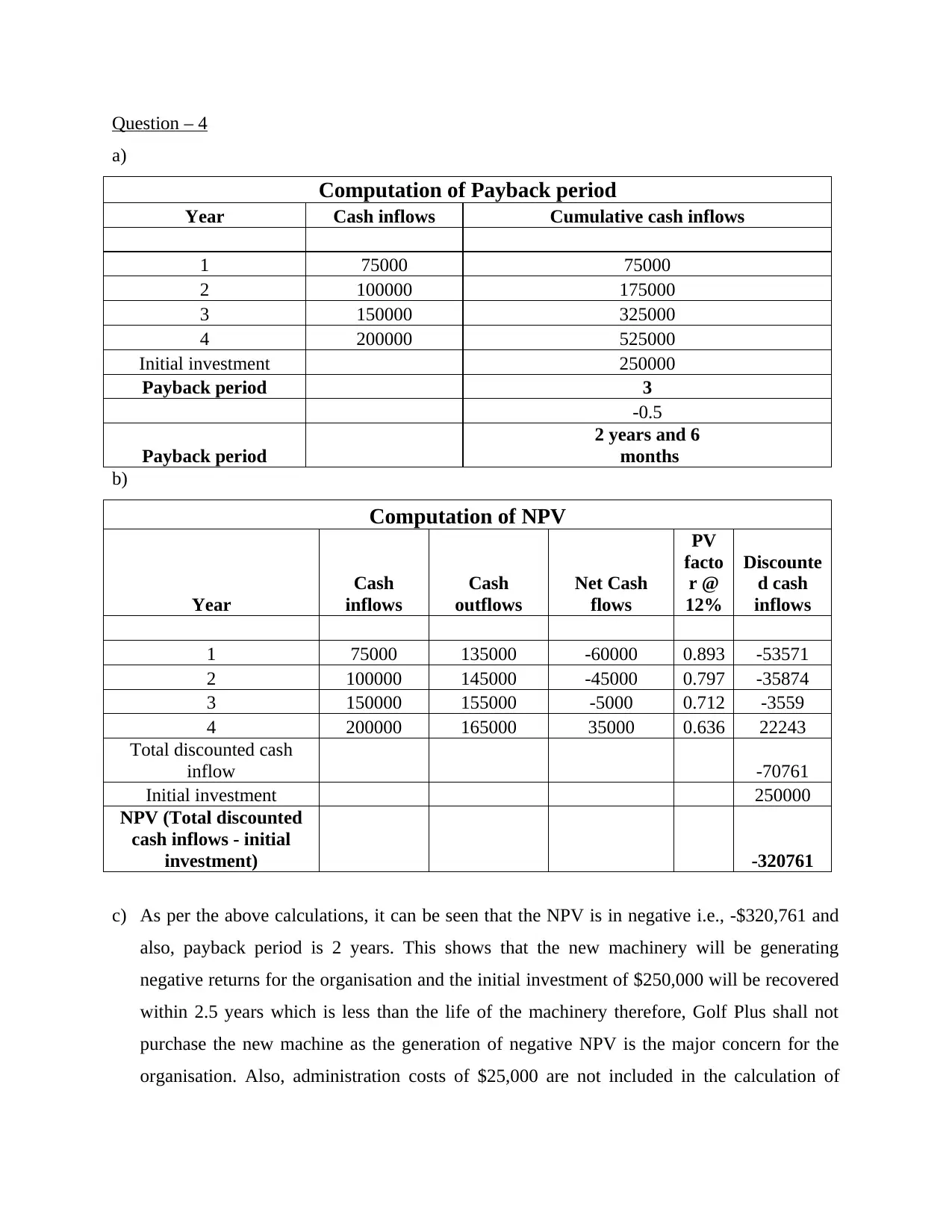
Question – 4
a)
Computation of Payback period
Year Cash inflows Cumulative cash inflows
1 75000 75000
2 100000 175000
3 150000 325000
4 200000 525000
Initial investment 250000
Payback period 3
-0.5
Payback period
2 years and 6
months
b)
Computation of NPV
Year
Cash
inflows
Cash
outflows
Net Cash
flows
PV
facto
r @
12%
Discounte
d cash
inflows
1 75000 135000 -60000 0.893 -53571
2 100000 145000 -45000 0.797 -35874
3 150000 155000 -5000 0.712 -3559
4 200000 165000 35000 0.636 22243
Total discounted cash
inflow -70761
Initial investment 250000
NPV (Total discounted
cash inflows - initial
investment) -320761
c) As per the above calculations, it can be seen that the NPV is in negative i.e., -$320,761 and
also, payback period is 2 years. This shows that the new machinery will be generating
negative returns for the organisation and the initial investment of $250,000 will be recovered
within 2.5 years which is less than the life of the machinery therefore, Golf Plus shall not
purchase the new machine as the generation of negative NPV is the major concern for the
organisation. Also, administration costs of $25,000 are not included in the calculation of
a)
Computation of Payback period
Year Cash inflows Cumulative cash inflows
1 75000 75000
2 100000 175000
3 150000 325000
4 200000 525000
Initial investment 250000
Payback period 3
-0.5
Payback period
2 years and 6
months
b)
Computation of NPV
Year
Cash
inflows
Cash
outflows
Net Cash
flows
PV
facto
r @
12%
Discounte
d cash
inflows
1 75000 135000 -60000 0.893 -53571
2 100000 145000 -45000 0.797 -35874
3 150000 155000 -5000 0.712 -3559
4 200000 165000 35000 0.636 22243
Total discounted cash
inflow -70761
Initial investment 250000
NPV (Total discounted
cash inflows - initial
investment) -320761
c) As per the above calculations, it can be seen that the NPV is in negative i.e., -$320,761 and
also, payback period is 2 years. This shows that the new machinery will be generating
negative returns for the organisation and the initial investment of $250,000 will be recovered
within 2.5 years which is less than the life of the machinery therefore, Golf Plus shall not
purchase the new machine as the generation of negative NPV is the major concern for the
organisation. Also, administration costs of $25,000 are not included in the calculation of
⊘ This is a preview!⊘
Do you want full access?
Subscribe today to unlock all pages.

Trusted by 1+ million students worldwide

NPV being not the direct costs for operation of the machine. Although such inclusion will not
affect the decision as the NPV will continue to be negative.
d) NPV is calculated in the terms of currency whereas, in payback period, time period is
calculated in which the initial investment will be recovered by the cash inflows of the
organisation from such a new machinery (Zhang, 2021). Payback period does not take into
account the time value of money while, NPV takes into account the time value of money.
Therefore, it can be said that NPV is a more suitable tool for Golf Plus for decision – making
on such purchase of new machinery and it is recommended not to purchase such a machinery
because taking into account time value of money along with the cash outflows, negative NPV
is an issue which no organisation shall be facing.
Question – 5
a) Advantages of Balance Scorecard approach:
Structured business strategy – This approach provides the company with a common
ground for measurement of success as the measures of performance will fall in a set
structure which is understandable in the whole organisation (Sanchez-Marquez and et.al.,
2020).
Easy communication – This approach will lead to implementation of performance
measures which will be common for the whole organisation and thus, discussion about
the strategies and progress will become easier.
Disadvantages of Balance Scorecard approach:
Must be customized – This approach will have to be customized and tailored according
to the operations of the organisation for which it has to be implemented which ends up
taking a lot of time.
Complicacy – This approach is complicated to understand as there are wide range of
resources and case studies that needs to be read and understood.
b) Now, there are various perspectives to the mission statement of Golf Plus for which goals
need to be set which will be achieved for the ultimate achievement of the mission statement
which are as follows:
Learning & Growth Perspective and Financial Data Perspective – Customer
satisfaction, environment friendliness and profitability – To be able to achieve customer
affect the decision as the NPV will continue to be negative.
d) NPV is calculated in the terms of currency whereas, in payback period, time period is
calculated in which the initial investment will be recovered by the cash inflows of the
organisation from such a new machinery (Zhang, 2021). Payback period does not take into
account the time value of money while, NPV takes into account the time value of money.
Therefore, it can be said that NPV is a more suitable tool for Golf Plus for decision – making
on such purchase of new machinery and it is recommended not to purchase such a machinery
because taking into account time value of money along with the cash outflows, negative NPV
is an issue which no organisation shall be facing.
Question – 5
a) Advantages of Balance Scorecard approach:
Structured business strategy – This approach provides the company with a common
ground for measurement of success as the measures of performance will fall in a set
structure which is understandable in the whole organisation (Sanchez-Marquez and et.al.,
2020).
Easy communication – This approach will lead to implementation of performance
measures which will be common for the whole organisation and thus, discussion about
the strategies and progress will become easier.
Disadvantages of Balance Scorecard approach:
Must be customized – This approach will have to be customized and tailored according
to the operations of the organisation for which it has to be implemented which ends up
taking a lot of time.
Complicacy – This approach is complicated to understand as there are wide range of
resources and case studies that needs to be read and understood.
b) Now, there are various perspectives to the mission statement of Golf Plus for which goals
need to be set which will be achieved for the ultimate achievement of the mission statement
which are as follows:
Learning & Growth Perspective and Financial Data Perspective – Customer
satisfaction, environment friendliness and profitability – To be able to achieve customer
Paraphrase This Document
Need a fresh take? Get an instant paraphrase of this document with our AI Paraphraser

satisfaction along with being operating on sustainable front and most importantly, being
profitable and increase the volume of business.
Business Processes Perspective – Production of high quality golf clubs – To be able to
focus on the processes of business for producing the high quality clubs for the customers.
Customer perspective – Suitability of the clubs to the individual using it – To be able to
produce such types of clubs which will be addressing the individual needs of the golfers
to enhance their playing experience.
c) Measures for each perspective:
Learning and growth – This is done through investigating the resources of training and
knowledge (Junior, de Oliveira and Helleno, 2018). It includes the efficient handling of
the information collected and effective utilization of this information to the competitive
advantage of the company.
Business process – The processes are investigated for their appropriateness for the
efficient manufacturing of the products. It includes operational management for tracking
of any possible gaps, bottlenecks, waste, etc.
Customer perspective – This is done for measuring the customer satisfaction with
regards to quality, price and availability of the product which is done through getting
feedbacks from the customers.
Financial data – This will include data regarding sales, expenses, revenues, etc. for
analysing of the financial performance through various measures ratios, variances, etc.
profitable and increase the volume of business.
Business Processes Perspective – Production of high quality golf clubs – To be able to
focus on the processes of business for producing the high quality clubs for the customers.
Customer perspective – Suitability of the clubs to the individual using it – To be able to
produce such types of clubs which will be addressing the individual needs of the golfers
to enhance their playing experience.
c) Measures for each perspective:
Learning and growth – This is done through investigating the resources of training and
knowledge (Junior, de Oliveira and Helleno, 2018). It includes the efficient handling of
the information collected and effective utilization of this information to the competitive
advantage of the company.
Business process – The processes are investigated for their appropriateness for the
efficient manufacturing of the products. It includes operational management for tracking
of any possible gaps, bottlenecks, waste, etc.
Customer perspective – This is done for measuring the customer satisfaction with
regards to quality, price and availability of the product which is done through getting
feedbacks from the customers.
Financial data – This will include data regarding sales, expenses, revenues, etc. for
analysing of the financial performance through various measures ratios, variances, etc.
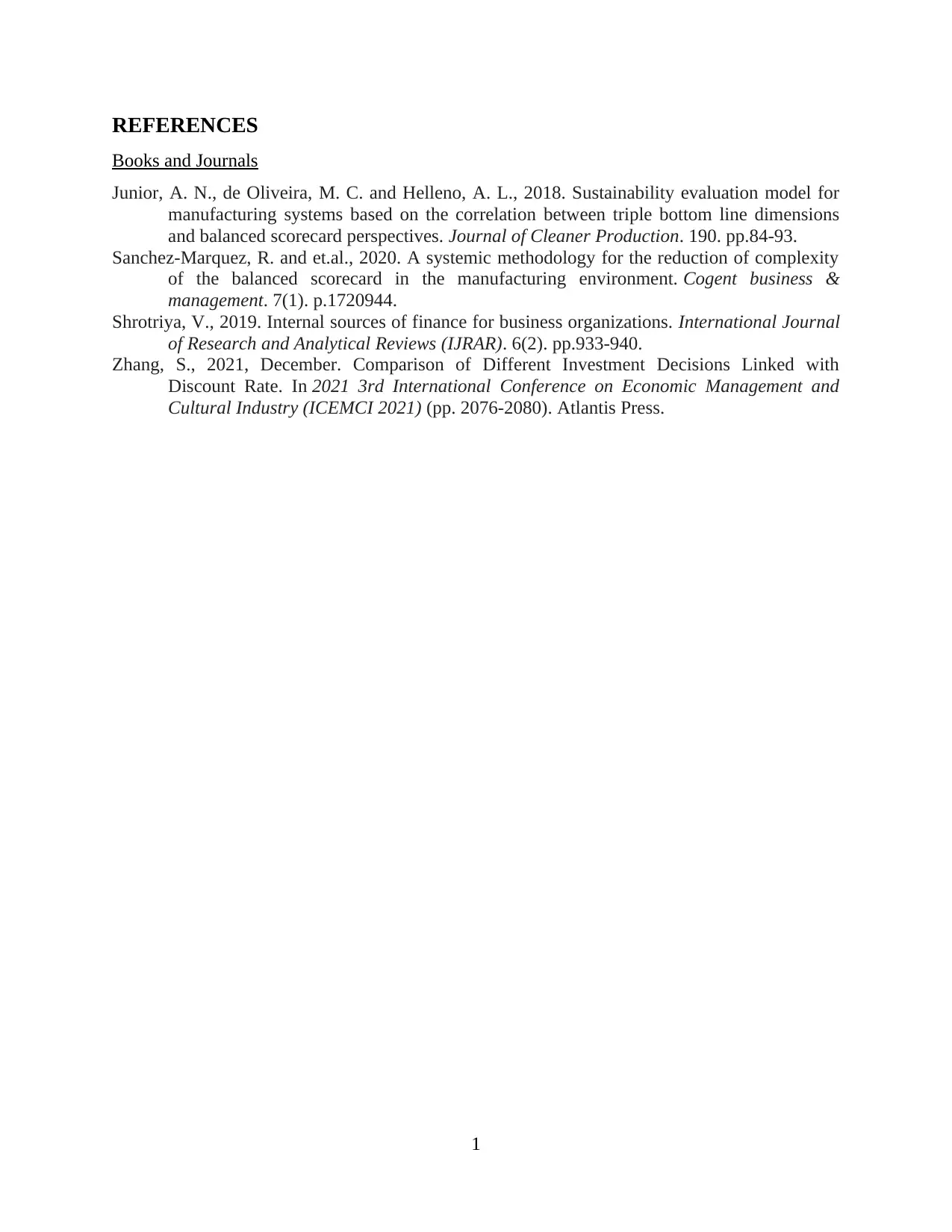
REFERENCES
Books and Journals
Junior, A. N., de Oliveira, M. C. and Helleno, A. L., 2018. Sustainability evaluation model for
manufacturing systems based on the correlation between triple bottom line dimensions
and balanced scorecard perspectives. Journal of Cleaner Production. 190. pp.84-93.
Sanchez-Marquez, R. and et.al., 2020. A systemic methodology for the reduction of complexity
of the balanced scorecard in the manufacturing environment. Cogent business &
management. 7(1). p.1720944.
Shrotriya, V., 2019. Internal sources of finance for business organizations. International Journal
of Research and Analytical Reviews (IJRAR). 6(2). pp.933-940.
Zhang, S., 2021, December. Comparison of Different Investment Decisions Linked with
Discount Rate. In 2021 3rd International Conference on Economic Management and
Cultural Industry (ICEMCI 2021) (pp. 2076-2080). Atlantis Press.
1
Books and Journals
Junior, A. N., de Oliveira, M. C. and Helleno, A. L., 2018. Sustainability evaluation model for
manufacturing systems based on the correlation between triple bottom line dimensions
and balanced scorecard perspectives. Journal of Cleaner Production. 190. pp.84-93.
Sanchez-Marquez, R. and et.al., 2020. A systemic methodology for the reduction of complexity
of the balanced scorecard in the manufacturing environment. Cogent business &
management. 7(1). p.1720944.
Shrotriya, V., 2019. Internal sources of finance for business organizations. International Journal
of Research and Analytical Reviews (IJRAR). 6(2). pp.933-940.
Zhang, S., 2021, December. Comparison of Different Investment Decisions Linked with
Discount Rate. In 2021 3rd International Conference on Economic Management and
Cultural Industry (ICEMCI 2021) (pp. 2076-2080). Atlantis Press.
1
⊘ This is a preview!⊘
Do you want full access?
Subscribe today to unlock all pages.

Trusted by 1+ million students worldwide
1 out of 9
Related Documents
Your All-in-One AI-Powered Toolkit for Academic Success.
+13062052269
info@desklib.com
Available 24*7 on WhatsApp / Email
![[object Object]](/_next/static/media/star-bottom.7253800d.svg)
Unlock your academic potential
© 2024 | Zucol Services PVT LTD | All rights reserved.





